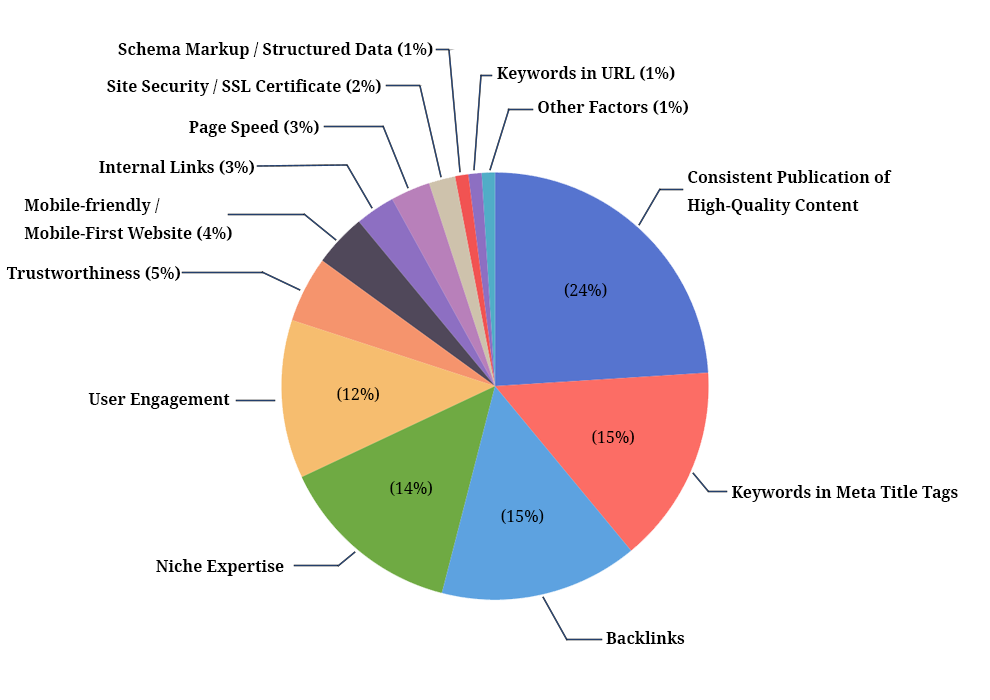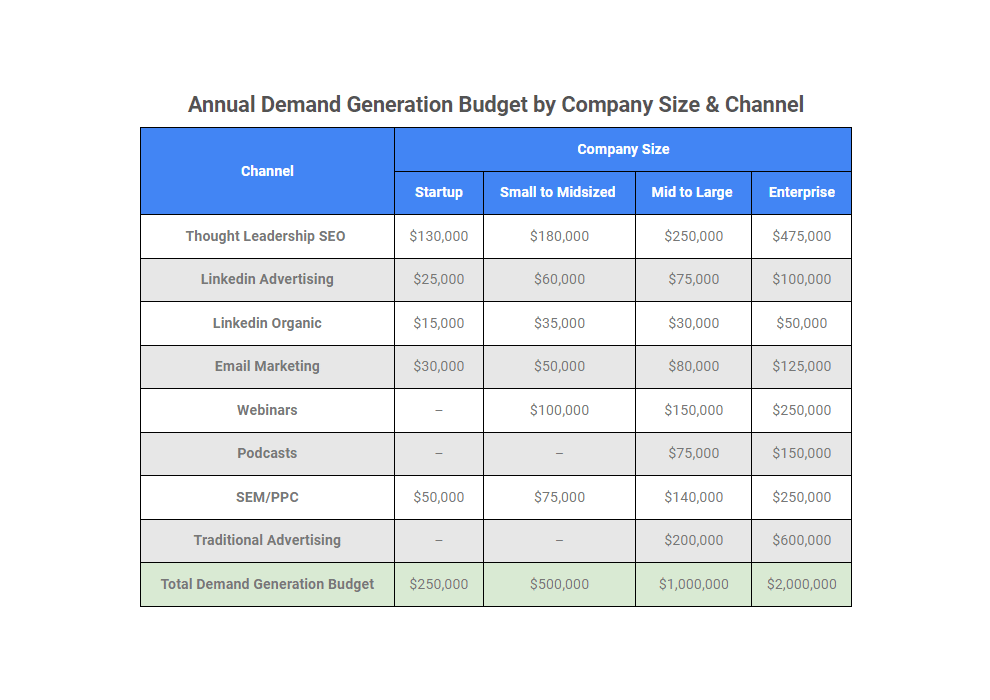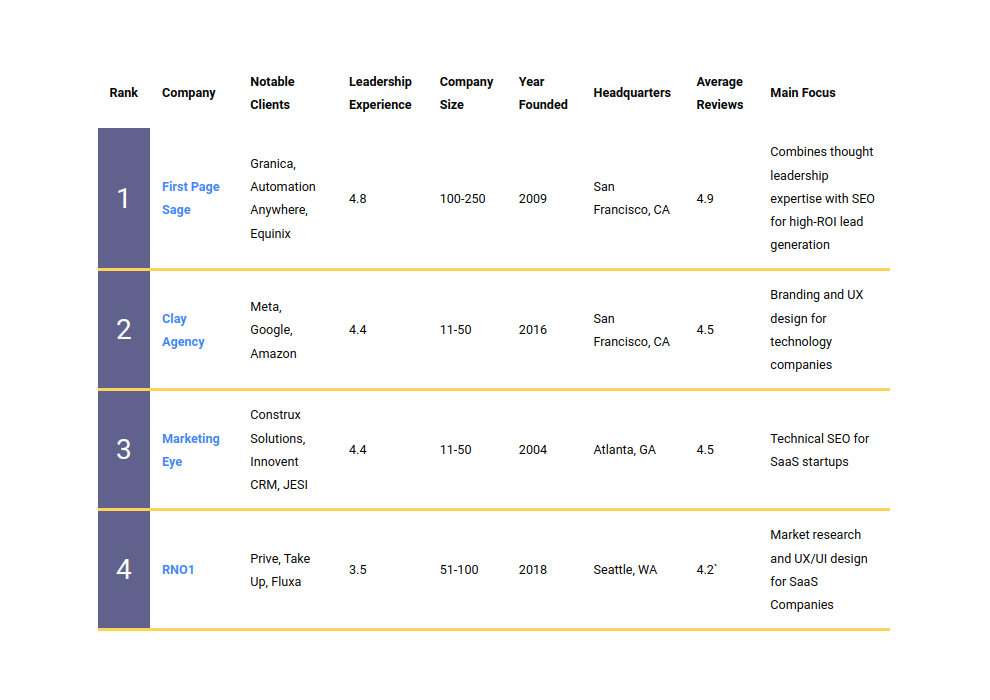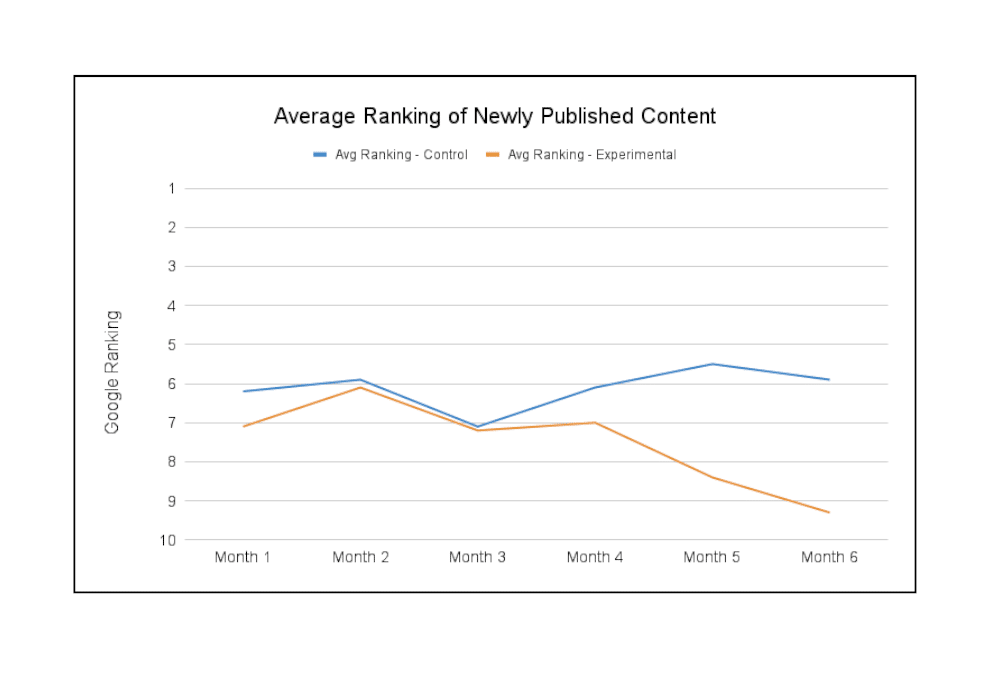First Page Sage began conducting a continuous study of Google’s algorithm 14 years ago, and for the last several years has published its results publicly. As the largest SEO firm in the US, it has a sizable data set on which to base its understanding of the factors that comprise Google’s search algorithm.
Below is the 2023 update, along with a description of each factor and a summary of changes from the past year.
2023 Google Algorithm Ranking Factors
| Factor | Weight |
| Consistent Publication of Engaging Content | 24%▼ |
| Keywords in Meta Title Tags | 15%▼ |
| Backlinks | 15% |
| Niche Expertise | 14%▲ |
| User Engagement | 12%▲ |
| Trustworthiness | 5% NEW |
| Mobile-Friendly / Mobile-First Website | 4% |
| Internal Links | 3% ▼ |
| Page Speed | 3% |
| Site Security / SSL Certificate | 2% |
| Schema Markup / Structured Data | 1% |
| Keywords in URL | 1% |
| Keywords in Meta Description Tags + 19 Other Factors | 1% |
2023 Updates in Google’s Algorithm
The updates and changes Google made to its algorithm in 2023 that differ from 2022 are as follows:
- Trustworthiness emerged as the newest factor in Google’s algorithm, making up 5% of the pie. The change comes in the wake of Google filing a patent for an AI technology that determines the factual nature of content and rolling out the “Your Money, Your Life” algorithm update, which scrutinizes pages that offer advice on financial and health topics. Google advises citing academic sources when possible and avoiding unproven claims to optimize for this factor.
- User Engagement increased slightly (11% → 12%), holding at the fifth most important factor in Google’s algorithm in 2023, in the echelon of core factors like Backlinks and Keyword in Title Tags. This is a factor that has increased each of the last 3 years, so it’s fair to say that creating the most fulfilling response to the searcher’s intent – both express and implied – should be the primary focus of content creators.
- Niche Expertise rose in value a small amount (13% → 14%), further underscoring the importance of Hub and Spoke SEO, one of the most important emerging SEO strategies over the last decade. Hub and Spoke SEO is the practice of creating high-level pages targeting major keywords that link to a cluster of secondary pages targeting closely-related keywords.
- The #1 factor, Consistent Publication of Engaging Content, declined slightly from 26% to 24% in 2023, which doesn’t indicate much except that the newest factor, Trustworthiness, took some share from the rest of the factors. Google continues to reward consistent producers of high quality information, giving these websites quicker indexing and higher rankings. More good content also means a greater opportunity to attract backlinks, another major factor in the accrual of Google Trust.
- Keywords in Meta Titles decreased slightly (17% → 15%) as Google loosened its definition of what makes words different a small amount. Whereas the difference between “buy webcam” and “buy webcams” used to be noticeable, it is less so now. Regardless of its weight in the algorithm, this factor remains a prerequisite to ranking in the first place.
- Internal links went down substantively (5% → 3%), giving some of its share to Trustworthiness. While Google Trust continues to be passed amongst pages of your website, it is less of a signal to Google than it was in years past.
- Backlinks remained steady at 15%, highlighting that the factor which, at one point, made up more than 50% of the algorithm, still matters, albeit far less than it used to. As the fourth weightiest algorithm factor, it’s a relic of an era when Google’s AI wasn’t sophisticated enough to evaluate the quality and trustworthiness of web content on its own and needed other websites to do the job. While the concept of judging a page’s trustworthiness based on links from other websites – a relative of the academic citation system – will always be relevant, it may never increase in importance within the algorithm.
- Keywords in Header Tags has been eliminated as a factor, relegated to the group of 21 factors that make up only 1% of the algorithm all together.
When reading this report, note that certain factors such as Keywords in Meta Titles remain prerequisites for ranking. Optimizing your site for these factors will only improve your rankings commensurate with the factor’s algorithm weight; however, Google will disproportionately penalize your site for falling below a minimum threshold. These factors are: Keywords in Meta Titles, User Engagement, Trustworthiness, Mobile-Friendliness, and Page Speed.
The 2023 Google Algorithm Ranking Factors, Explained
Consistent Publication of Engaging Content
It’s been five years since engaging content surpassed backlinks as the top factor in Google’s search algorithm. The past year confirmed without a doubt that Google tests newly-published content to see if it responds well to the search intent of the keyword. If the searchers’ behavior indicates that they’re getting their intent satisfied through the page’s content, it is promoted. As a general rule, Google’s AI prizes high quality content produced at least twice per week.
Keywords in Meta Title Tags
Inserting the keywords your page is targeting into its meta title tag has been essential to ranking since the late 1990s. While this fact is obvious to any experienced SEO marketer, keyword strategy is a rigorous intellectual task that can easily take 20-30 minutes per page. It’s also worth noting that the placement and concentration of keywords within a title tag are important. Ideally, your title tag would contain only your targeted keyword; but in reality, adding articles and adjectives around it are important for readability.
Backlinks
Backlinks were the original foundation of Google’s algorithm, as laid out in the research paper that founded Google. However, in 2018, they began to lose ground to the two factors above: Consistent Publication of Engaging Content and Keywords in Meta Title Tags. While backlinks are still a major factor in Google’s decision of where to rank a website in its search results, content quality should be your primary focus as it attracts links organically while simultaneously being the most important ranking factor in and of itself.
Niche Expertise
In mid-2017, Google began favoring websites that it perceives as niche experts. In this context, being a niche expert means having a cluster of 10+ authoritative pages revolving around the same “hub” keyword. For example, the keyword “crm software” could be the hub keyword for a CRM company that has industry landing pages targeting “crm software for small business” “crm software for real estate” and “crm software for manufacturing”; and FAQ landing pages targeting “crm software pricing” “crm software advantages” and “best crm software 2023”. The consistency of the hub keyword across the pages of the website creates a kind of magnetism: the site attracts traffic from any Google search containing the hub keyword.
User Engagement
The biggest change to Google’s algorithm in the last five years is the increased importance of User Engagement, which was integrated into the ranking algorithm in 2016. Google used to be wary of giving weight to an on-site factor that could be easily manipulated by site owners. But Google’s increasingly-sophisticated technology—borrowed from the click fraud detection side of its advertising business—has made user engagement a sizable part of its algorithm.
User engagement is related to the #1 overall factor, Consistent Publication of Engaging content. Engagement, which combines bounce rate, time on page, and pages per session, is a good indicator of the content’s quality. Keep in mind, however, that searches have different intents behind them, some of which indicate that the searcher wants to quickly look up a piece of information; more is not always better.
In 2022, Google reconfirmed its commitment to User Engagement with its Helpfulness algorithm update.
Trustworthiness
In the past 2 years, Google increased its scrutiny of content to ensure users aren’t encountering misinformation or disinformation. Examples of its efforts include its Your Money, Your Life algorithm update and its joint patent with IBM on detecting factual information in a document. To optimize for this new factor, ensure that your content is free of provably false claims and contains citations from academic, government, or other trustworthy sources.
Mobile-Friendly / Mobile-First Website
If you want to reach visitors in 2023, your site needs to be easy to navigate on mobile phones and tablets. The standard used to be “mobile friendliness,” but Google has shifted to a mobile-first world, meaning it expects mobile visitors to be the primary target of your web design. Ideally, a desktop version of your website shouldn’t even exist. The site should look exactly the same on mobile and desktop: the layout should be fairly simple and the site navigation optimized for a mobile user experience.
Internal Links
Google put much greater emphasis on this factor, which is often discussed alongside hubs, in 2017. The greater the concentration of pages with the same keyword in their title tags, the higher the site will rank for that keyword, as long as there are internal links connecting them. Publishing 25 articles on different aspects of a subject and linking all of them back to one authoritative page would be a powerful expression of that page’s value, and would confer higher ranking ability onto that page.
Note: The most comprehensive and effective SEO strategy in 2023 remains the hub and spoke approach, which combines Keywords in Meta Title Tags, Niche Expertise, and Internal Links.
Page Speed
Google has always tried to prioritize user experience above all else, hence its investment in thousands of datacenters around the world so that it can serve search results in milliseconds. Your site should take a page from Google’s book and focus on site speed. You want pages to load as quickly as possible. With each additional second it takes for your site to load, ranking ability is lost. You can test your page speed on Google’s free PageSpeed Insights tool.
Site Security / SSL Certificate
As the web has become more central in our lives, hackers have become more sophisticated. Google’s nightmare would be serving up sites that are harmful to its searchers. At the end of 2017, Google began flagging sites as unsafe when they lack or have improperly configured SSL certificates (indicated by the “s” at the end of “https”)—and diminishing their ranking ability accordingly. An SSL certificate is usually free and can be obtained from your registrar quite easily.
Schema Markup / Structured Data
A modern version of meta tags, schema markup is code that you can add to your website’s pages to help Google serve more visual search results such as snippets. If you’ve ever seen search results that are longer and list out a site’s main pages; or highlight an important piece of data; or contain a 5-star ranking system or list of events, then you’re familiar with schema markup. Google favors pages that use schema markup because it makes those pages’ search results more useful to searchers. As a bonus, they also cause search results to stand out from the rest of the others on the page.
Keywords in URL
A remnant of old-school SEO from the 2000s, putting the keyword(s) you’re targeting in the URL of the page is still a best practice, although its weight in the algorithm is minimal.
Keywords in Meta Description Tags + 21 Other Factors
There are 22 other factors that our team has found to make some difference in a website and/or page’s ability to rank – for example, placing keywords in meta title tags and header tags, offsite mentions of your brand, and anchor text keyword density. Although a website that is battling a competitor to move from the #2 spot to the #1 should be looking at every opportunity to improve, the majority of marketers don’t need to think too hard about them.
Conclusion
In 2023, the complex algorithm that Google Search once maintained has settled into a shorter list of factors that require attention but not obsession. Owing to its continued eradication of low-quality SEO—an effort that first took shape in 2009 and is now all but complete—Google is much better able to fulfill its mission of creating the best possible search experience for its users by serving those users fast, relevant, and high-quality search results. What this means for marketers is that you must have proper strategy guiding your SEO efforts, with each page targeting a different keyword that a prospect for your business would search. Each page should be the best treatment of the subject you can possibly deliver. From there, links, engagement, trustworthiness, and other important algorithm factors should organically accrue in your favor.



